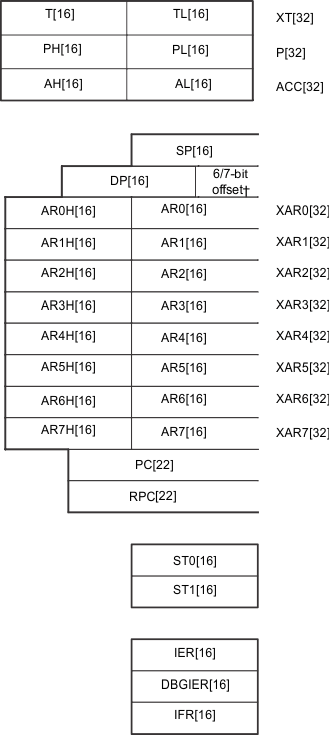SPRAC71B February 2019 – October 2023
- 1
- 1 Introduction
- 2 Data Representation
-
3 Calling Conventions
- 3.1 Call and Return
- 3.2 Register Conventions
- 3.3 Argument Passing
- 3.4 Return Values
- 3.5 Structures and Unions Passed and Returned by Reference
- 3.6 Conventions for Compiler Helper Functions
- 3.7 Prolog and Epilog Helper Functions
- 3.8 Scratch Registers for Functions Already Seen
- 3.9 Interrupt Functions
- 4 Data Allocation and Addressing
- 5 Code Allocation and Addressing
- 6 Helper Function API
-
7 Standard C Library API
- 7.1 About Standard C Libraries
- 7.2 Reserved Symbols
- 7.3 <assert.h> Implementation
- 7.4 <complex.h> Implementation
- 7.5 <ctype.h> Implementation
- 7.6 <errno.h> Implementation
- 7.7 <float.h> Implementation
- 7.8 <inttypes.h> Implementation
- 7.9 <iso646.h> Implementation
- 7.10 <limits.h> Implementation
- 7.11 <locale.h> Implementation
- 7.12 <math.h> Implementation
- 7.13 <setjmp.h> Implementation
- 7.14 <signal.h> Implementation
- 7.15 <stdarg.h> Implementation
- 7.16 <stdbool.h> Implementation
- 7.17 <stddef.h> Implementation
- 7.18 <stdint.h> Implementation
- 7.19 <stdio.h> Implementation
- 7.20 <stdlib.h> Implementation
- 7.21 <string.h> Implementation
- 7.22 <tgmath.h> Implementation
- 7.23 <time.h> Implementation
- 7.24 <wchar.h> Implementation
- 7.25 <wctype.h> Implementation
-
8 C++ ABI
- 8.1 Limits (GC++ABI 1.2)
- 8.2 Export Template (GC++ABI 1.4.2)
- 8.3 Data Layout (GC++ABI Chapter 2)
- 8.4 Initialization Guard Variables (GC++ABI 2.8)
- 8.5 Constructor Return Value (GC++ABI 3.1.5)
- 8.6 One-Time Construction API (GC++ABI 3.3.2)
- 8.7 Controlling Object Construction Order (GC++ ABI 3.3.4)
- 8.8 Demangler API (GC++ABI 3.4)
- 8.9 Static Data (GC++ ABI 5.2.2)
- 8.10 Virtual Tables and the Key function (GC++ABI 5.2.3)
- 8.11 Unwind Table Location (GC++ABI 5.3)
-
9 Exception Handling
- 9.1 Overview
- 9.2 PREL31 Encoding
- 9.3 The Exception Index Table (EXIDX)
- 9.4 The Exception Handling Instruction Table (EXTAB)
- 9.5 Unwinding Instructions
- 9.6 Descriptors
- 9.7 Special Sections
- 9.8 Interaction With Non-C++ Code
- 9.9 Interaction With System Features
- 9.10 Assembly Language Operators in the TI Toolchain
- 10DWARF
- 11ELF Object Files (Processor Supplement)
- 12ELF Program Loading and Linking (Processor Supplement)
- 13Build Attributes
- 14Copy Tables and Variable Initialization
- 15Revision History
3.2 Register Conventions
Implementations must not use the special-purpose registers for any purpose other than the dedicated special purpose. The remaining registers are general-purpose registers.
SP is the call stack pointer. The stack pointer must always remain properly aligned, even during hand-coded assembly functions (see Section 4.6.1). TMS320C28x requires alignment to 16-bit words. Stack management and the local frame structure is presented in Section 4.6.
The ABI designates the following as callee-saved registers. That is, a called function is expected to preserve them so they have the same value on return from a function as they had at the point of the call.
- XAR1-XAR3
- R4H-R7H (on FPU32)
- R4L-R7L (on FPU64)
All other registers are caller-save registers. That is, they are not preserved across a call, so if their value is needed following the call, the caller is responsible for saving and restoring their contents.
| Register | Size | Description |
|---|---|---|
| ACC | 32 bits | Accumulator |
| AH | 16 bits | High half of ACC |
| AL | 16 bits | Low half of ACC |
| XAR0 | 16 bits | Auxiliary register 0 |
| XAR1 | 32 bits | Auxiliary register 1 |
| XAR2 | 32 bits | Auxiliary register 2 |
| XAR3 | 32 bits | Auxiliary register 3 |
| XAR4 | 32 bits | Auxiliary register 4 |
| XAR5 | 32 bits | Auxiliary register 5 |
| XAR6 | 32 bits | Auxiliary register 6 |
| XAR7 | 32 bits | Auxiliary register 7 |
| AR0 | 16 bits | Low half of XAR0 |
| AR1 | 16 bits | Low half of XAR1 |
| AR2 | 16 bits | Low half of XAR2 |
| AR3 | 16 bits | Low half of XAR3 |
| AR4 | 16 bits | Low half of XAR4 |
| AR5 | 16 bits | Low half of XAR5 |
| AR6 | 16 bits | Low half of XAR6 |
| AR7 | 16 bits | Low half of XAR7 |
| DP | 16 bits | Data-page pointer |
| IFR | 16 bits | Interrupt flag register |
| IER | 16 bits | Interrupt enable register |
| DBGIER | 16 bits | Debug interrupt enable register |
| P | 32 bits | Product register |
| PH | 16 bits | High half of P |
| PL | 16 bits | Low half of P |
| PC | 22 bits | Program counter |
| RPC | 22 bits | Return program counte |
| SP | 16 bits | Stack pointer |
| ST0 | 16 bits | Status register 0 |
| ST1 | 16 bits | Status register 1 |
| XT | 32 bits | Multiplicand register |
| T | 16 bits | High half of XT |
| TL | 16 bits | Low half of XT |
In addition, some devices have an FPU instruction set, which adds registers R0-R7.
Figure 3-1 shows the C28x registers. See the TMS320C28x DSP CPU and Instruction Set Reference Guide (SPRU430) for more information about the registers.
 Figure 3-1 C28x Registers
Figure 3-1 C28x Registers